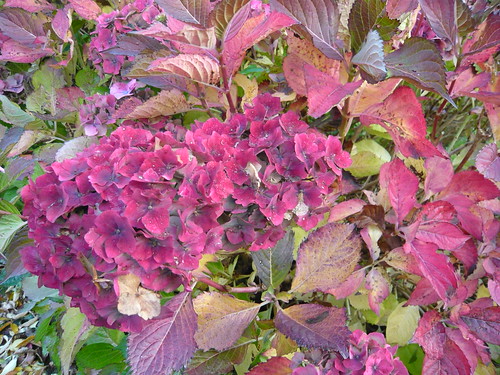Hydrangeas Gardeners Tips
Hydra may be a monster but Hydrangeas can be stunningly beautiful.

Hydrangea are easy to grow, voluminous shrubs with long lasting flower-heads. They can grow to be handsome 6 foot high and wide shrubs.
Growing Hydrangea Early autumn is the best time to plant new Hydrangeas. If planting in spring take more care with watering and mulch the plants to keep the soil damp. Hydrangeas grow best in semi shade in rich moist soil. Trim off old flower heads and dead stems in spring. Give them a balanced fertilizer in spring.
Choose the Right Variety Mophead or Hortensia hydrangeas are the type that have pompom like heads that open into a globe shape such as ‘Blue Bonnet’ or ‘Forever Pink’. Lacecap varieties have flat heads whose flowers do not open at the same time.
Quercifolias often have pyramid shaped white flowers and oak shaped leaves. Annabelle is the best known and well liked variety of Hydrangea arborescens.

Where to Plant Hydrangeas are good seaside plants tolerating salty air. Grow in shade or full sun but avoid early spring sun after frosts. Hydrangeas resist wind and only request a moist soil. Their characteristics make Hydrangeas good on the edge of woodland or as an informal hedge. Pot grown varieties are popular as house plants that can be planted in the garden when they are finished in the house.
Drying Hydrangeas can provide decoration out of season and tips can be found on the Hydrangea web site.
See Thorp Perrow Hydrangeas
Hydrangea colouring. Alkaline soil produces pink flowers and acidic soil blue flowers. You can add Aluminium sulphate to get blue flowers or lime to change to pink flowers. White varieties will not change colour.
Hydrangea macrophylla produce slightly different colour tones depending on the soil pH. See Help to change Hydrangea colour
RHS hydrangeas including climbing hydrangeas
Great seaside flowering shrubs and a powerful garden statement. There are a wide range of species and you get ‘a good bang for your buck’.

Hydrangeas are voluminous shrubs with lasting flowers. They are easy to grow even in windy locations and the flowers are good for cutting (add a little liquid soap and sugar to the water so they last longer). As the name suggests they like water or at least a moisture retentive soil.
-
- New Hydrangeas can be planted in Autumn with a good mulch of shredded bark or compost.
- In Spring cut out old flower heads and dead stems. Cut just above an outward facing bud.
- To make the flowers blue add Aluminium Sulphate to the soil. Lime makes them pink.
- In summer cut out any leafless stems.
- Buy new plants in bloom so you know what the flowers look like. Avoid plants with brown or spotted leaves.
- Hortensa Hydrangeas look like pompoms or mopheads often seen at seaside locations. Lacecap varieties open flat. Paniculata and quercifolia have conical flowers often white.
For more information try All about Hydrangeas

3 thoughts on “Hydrangeas Gardeners Tips”
when i bought my hydrangeaqs plant it had blue beautiful flowers, for the next two years – no flowers, why?
is there something i should do when it is winter? do i cover them?
do i cut them down to a foot?
I have two of them they give beautiful green leaves but that is all.
Do not cut down or prune – you will cut off the flower buds for next year.
A late frosts can damage the flower buds as well. I leave old papery seed heads on until spring for some protection. If there is a heavy late frost when your buds have started to swell you can cover the plants in horticultural fleece.
Let the grow and you will get flowers again – Hydrangeas are long lived plants
Comments are closed.